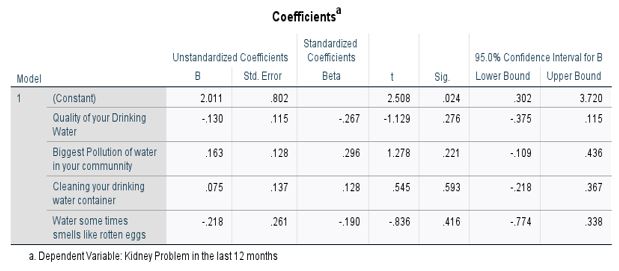Effect of Water Pollution on Public Health, in Bassin Bleu a small community in the Northwest of Haiti
DOI:
https://doi.org/10.5281/zenodo.16741871Keywords:
water pollution, public health, water quality, waterborne diseases, drinking water, waterAbstract
The study attempted to determine the level of water pollution and to examine how Water Pollution affects Public Health in Bassin Bleu, a small community in the northwest of Haiti because Water pollution is a significant problem that requires special attention to deal with the emerging water crisis. This study aims to determine the effect of water pollution on public health in Bassin Bleu. A total of 35 questionnaires were distributed, 20 were collected. The results revealed that the participants are not satisfied with the quality of water provided in their community; they stated sediments, trash, and chemicals contaminate the drinking water. By given the importance of potable water for health, which is essential in providing the best quality of the community, several suggestions are made.
This investigation aimed to determine the level of vulnerability of the inhabitants of Bassin Bleu to the effects of water pollution. Data were collected in the area setting through a questionnaire.
We can realize that none of the participants are satisfied with the quality of water provided in their community. The polluted water has led to the spread of certain dangerous infectious diseases such as diarrhea, dysentery, typhoid, kidney problem in the area. Therefore, it is necessary to make interventions with the participation of the population to bring lasting solutions for the wellbeing of the community.
Downloads
References
Ab Razak, N. H., Praveena, S. M., Aris, A. Z., & Hashim, Z. (2016). Quality of Kelantan drinking water and knowledge, attitude, and practice among the population of Pasir Mas. Malaysia. Public health References.
Abraham, J. P., Plourde, B. D., & Minkowycz, W. J. (2015). Continuous flow solar thermal pasteurization of drinking water: methods, devices, microbiology, and analysis. Renewable Energy, 81, 795-803.Clean Water.
Akers, D. B., MacCarthy, M. F., Cunningham, J. A., Annis, J., & Mihelcic, J. R. (2015). Lead (Pb) Contamination of self-supply groundwater systems in coastal madagascar and predictions of blood lead levels in exposed children. Environmental Science & Technology.
Anderson, B. A., Romani, J. H., Phillips, H. E., & van Zyl, J. A. (2002). Environment, access to health care, and other factors affecting infant and child survival among the African and Coloured populations of South Africa, 1989-94. Population and Environment.
Balkis, N. (2012). Water pollution.
Control for Disease Control and Prevention. (2018). Increasing access to improved water and sanitation.
Clasen, T., Schmidt, W.P., Rabie, T., & Roberts, I. S. C. (2007). Interventions to improve water quality for preventing diarrhea: Systematic review and meta-analysis.
Colford, John M., Jr. (2005). Water, sanitation, and hygiene interventions to reduce diarrhea in less developed countries: a systematic review and meta-analysis. The Lancet Infectious Diseases.
Dean, J., & Hunter, P. R. (2012). Risk of gastrointestinal illness associated with the consumption of rainwater: a systematic review. Environmental Science & Technology, 46(5), 2501-2507.
Fewtrell, Lorna, Kaufmann, Rachel B., Kay, David, Enanoria, Wayne, Haller, Laurence, & Henaut, A. (2011). Air and water pollution.
Fisher, R.M. (2019). Environmental biology.
Kgalushi, S., & Eales, K. (2004). Informal settlements: A perpetual challenge.
Masters, S., Welter, G. J., & Edwards, M. (2016). Seasonal variations in lead release to potable water. Environmental Science & Technology.
Mehtab, H., Muhammad, F., Malik, A. J, Sidra A., Nayab, A., Sharon, Z.,. & Jaweria, H. (2017). Water Pollution and Human Health.
Philander, S.G. (2008). Encyclopdia of global warning and climate change.
Pierre Louis, K., Belvaux, E., Coates, D., Blumenfeld, S., Lu, C., Grekin, J., Nooman, K., Mooney, C.H., & Khara, E. (2010). Good practice guides, drinking water, biodiversity and development.
Tucker, R. (2016). Causes of 5 common taste and odor water issues.
World Program for Water Resources Assessment. (2009).
WHO. (2011). Guidelines for drinking -water quality. (4th ed.).
WHO/UNICEF. (2005c). Water, sanitation and hygiene.
WHO. (2019). Joint Monitoring Program (JMP) report.
WHO. (2019). Drinking- Water.
WHO. (2020). Water sanitation, and hygiene (WASH).
World Bank. (2019). Haiti faced with the challenge of access to drinking water.

Published
How to Cite
Issue
Section
ARK
License
Copyright (c) 2025 Omulda Lima Guerrier, MPH, RN, Willy Lima, PhD, Paul Gyles, PhD

This work is licensed under a Creative Commons Attribution 4.0 International License.
Research Articles in 'Social Science Journal for Advanced Research' are Open Access articles published under the Creative Commons CC BY License Creative Commons Attribution 4.0 International License http://creativecommons.org/licenses/by/4.0/. This license allows you to share – copy and redistribute the material in any medium or format. Adapt – remix, transform, and build upon the material for any purpose, even commercially.










